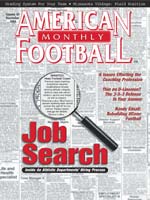AMERICAN FOOTBALL MONTHLY THE #1 RESOURCE FOR FOOTBALL COACHES
Article CategoriesAFM Magazine
|
A Dramatic JumpRandy Edsall Has UConn on the Map for Football - Not Basketballby: David Purdum © More from this issue Itís not supposed to be this easy. Teams simply cannot make the jump from Division I-AA to D I-A and immediately be competitive. The talent, the depth, it just isnít there. Division I-A has the SEC, the ACC, the PAC-10 and the Big 12. Thatís where the athletes are. Thatís where the good teams are. Not in Maine, Delaware... or Connecticut? The game is Ďa-changing.í The once hip and fresh spread offense is not so hip and fresh anymore. Freshmen are increasingly making an impact. Black Bears from Maine are making an impact. And so is UConn. Some call it parity, but thatís an insult to the up-and-coming programs. Some call Randy Edsallís Huskies competitive. Thatís also an insult. UConn was competitive in it....The full article can only be seen by subscribers. Subscribe today!
|
|
|||||||
| HOME |
MAGAZINE |
SUBSCRIBE | ONLINE COLUMNISTS | COACHING VIDEOS |
Copyright 2025, AmericanFootballMonthly.com
All Rights Reserved





